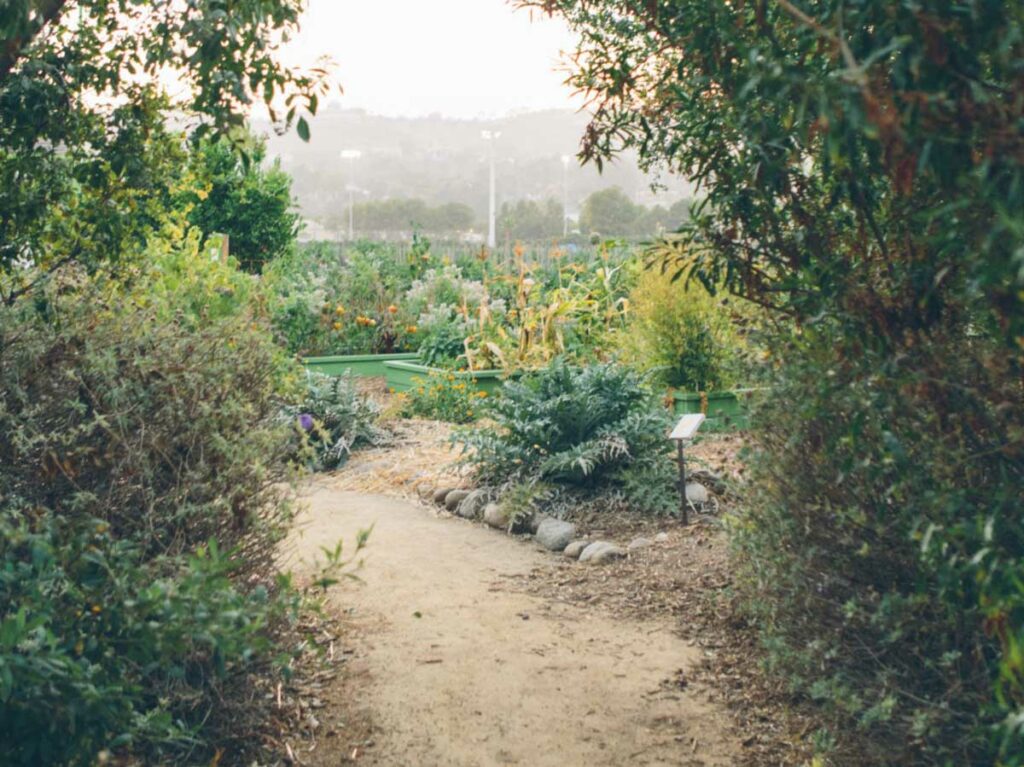Well-designed gardens produce the most food with the least work and are cheaper and easier to maintain. This month includes some basic principles and checklists to create your own design. You’ll also find inspiration and sample designs from actual Grow Your Own! gardens.
To start, here are some guidelines:
PLACE THINGS IN RELATIONSHIPS AND MAKE CONNECTIONS
- The way you arrange things in your garden design can greatly reduce the amount of work you do and the resources you need. For example, locating your chickens in the orchard will fertilize the trees and feed the chickens at the same time.
DRAW INSPIRATION FROM NATURAL SYSTEMS
- You are designing an ecosystem, so copy what nature does best. For example, a thick layer of mulch mimics the leaf litter in a forest- it protects your plants, directs water, and looks good. Companion planting helps your plants obtain proper nutrients and remain bug-free.
USE FULL-CIRCLE LOOPS
- Ideally, your waste products find a second life. For example, plant debris and veggie scraps provide nutrients for healthy soil when composted in a pile or worm bin.
CREATE ABUNDANCE AND SURPLUS
- Increase the stability of your garden system by selecting items that have multiple benefits. For example, a fruit tree provides a sweet seasonal treat and surplus for winter canning. It also cools buildings in the summer and provides habitat for shade-loving plants to grow beneath it.
START SMALL
- Design your garden to accommodate all your wishes, and plan to build in phases as you obtain more resources.
USE APPROPRIATE TECHNOLOGY AND TIME-TESTED, LOW-IMPACT METHODS
- For example, instead of starting with an expensive hydroponics system that depends on a constant supply of outside materials, try to become an expert in natural fertilizers first. You can make nutrient-rich compost and worm tea with ingredients from your own garden.
REINFORCE YOUR JOBS
- Your garden should be a resilient system, which means your basic needs are covered no matter what. For example, with watering, combine hand-watering with drip irrigation. This way, plants still get water even if one method breaks down.
DRAW INSPIRATION FROM NATURAL SYSTEMS
- You are designing an ecosystem, so copy what nature does best. For example, a thick layer of mulch mimics the leaf litter in a forest- it protects your plants, directs water, and looks good. Companion planting helps your plants obtain proper nutrients and remain bug-free.
USE FULL-CIRCLE LOOPS
- Ideally, your waste products find a second life. For example, plant debris and veggie scraps provide nutrients for healthy soil when composted in a pile or worm bin.
CREATE ABUNDANCE AND SURPLUS
- Increase the stability of your garden system by selecting items that have multiple benefits. For example, a fruit tree provides a sweet seasonal treat and surplus for winter canning. It also cools buildings in the summer and provides habitat for shade-loving plants to grow beneath it.
START SMALL
- Design your garden to accommodate all your wishes, and plan to build in phases as you obtain more resources.
USE APPROPRIATE TECHNOLOGY AND TIME-TESTED, LOW-IMPACT METHODS
- For example, instead of starting with an expensive hydroponics system that depends on a constant supply of outside materials, try to become an expert in natural fertilizers first. You can make nutrient-rich compost and worm tea with ingredients from your own garden.
REINFORCE YOUR JOBS
- Your garden should be a resilient system, which means your basic needs are covered no matter what. For example, with watering, combine hand-watering with drip irrigation. This way, plants still get water even if one method breaks down.








